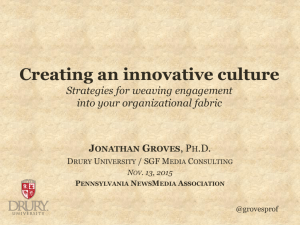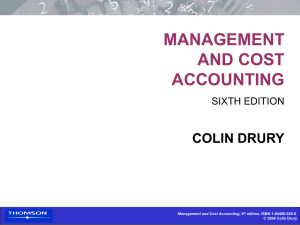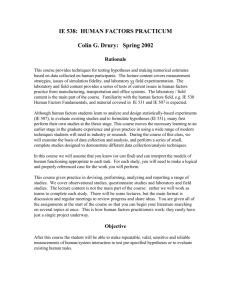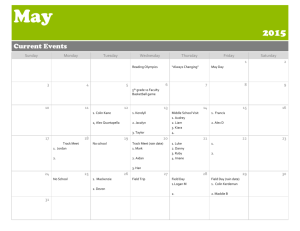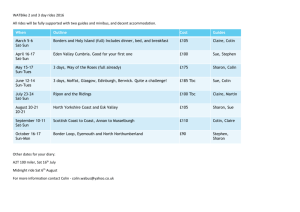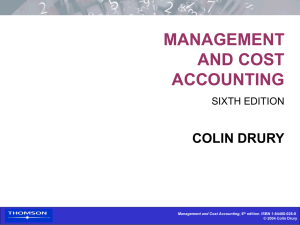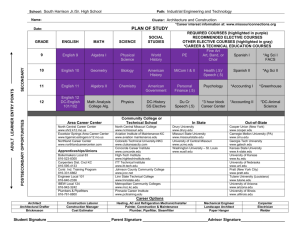Standard costing and variance analysis 1
advertisement
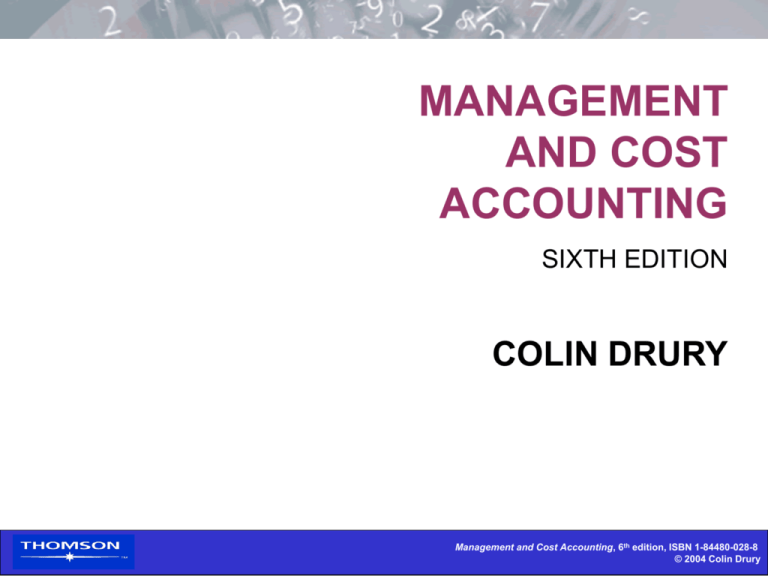
MANAGEMENT AND COST ACCOUNTING SIXTH EDITION COLIN DRURY Management and Cost Accounting, 6th edition, ISBN 1-84480-028-8 © 2004 Colin Drury Part Four: Information for planning, control and performance Chapter Eighteen: Standard costing and variance analysis 1 Management and Cost Accounting, 6th edition, ISBN 1-84480-028-8 © 2000 Colin Drury © 2004 Colin Drury 18.1a Definition • Standard costs are target costs for each operation that can be built up to produce a product standard cost. • A budget relates to the cost for the total activity,whereas standard relates to a cost per unit of activity. Management and Cost Accounting, 6th edition, ISBN 1-84480-028-8 © 2000 Colin Drury © 2004 Colin Drury 18.1b Operation of a standard costing system 1. Most suited to a series of common or repetitive organizations (this can result in the production of many different products). Management and Cost Accounting, 6th edition, ISBN 1-84480-028-8 © 2004 Colin Drury 18.1c Operation of a standard costing system (contd.) 2. Variances are traced to responsibility centres (not products). 3. Actual product costs are not required. 4. Comparisons after the event provide information for corrective action or highlight the need to revise the standards. Management and Cost Accounting, 6th edition, ISBN 1-84480-028-8 © 2000 Colin Drury © 2004 Colin Drury 18.2 An overview of a standard costing system Management and Cost Accounting, 6th edition, ISBN 1-84480-028-8 © 2000 Colin Drury © 2004 Colin Drury 18.3a Establishing cost standards 1. Two approaches: (i) past historical records (ii) engineering studies 2. Engineering studies A detailed study of each operation is undertaken: • direct material standards (standard quantity × standard prices) • direct labour standards (standard quantity × standard prices) • overhead standards: • cannot be directly observed and studied and traced to units of output; • analysed into fixed and variable elements; • fixed tend not to be controllable in the short term. Management and Cost Accounting, 6th edition, ISBN 1-84480-028-8 © 2000 Colin Drury © 2004 Colin Drury 18.3b Standard hours produced 1. Used to measure output where more than one product is produced. Example Standard (target) times: X = 5 hours, Y = 2 hours, Z = 3 hours Output = 100 units of X, 200 units of Y, 300 units of Z Standard hours produced = (100 × 5 hours) + (200 ×2 hours) + (300 ×3 hours) = 1 800 2. If actual DLH are less than 1 800 the department will be efficient,whereas if hours exceed 1 800 the department will be inefficient. Note:Different activity measures and other factors (besides activity)will influence cost behaviour. Management and Cost Accounting, 6th edition, ISBN 1-84480-028-8 © 2000 Colin Drury © 2004 Colin Drury 18.4 Purposes of standard costing 1. To provide a prediction of future costs that can be used for decision-making. 2. To provide a challenging target that individuals are motivated to achieve. 3. To assist in setting budgets and evaluating performance. 4. To act as a control device by highlighting those activities that do not conform to plan. 5. To simplify the task of tracing costs to products for inventory valuation. Figure 18.2 Standard costs for inventory valuation and profit measurement Management and Cost Accounting, 6th edition, ISBN 1-84480-028-8 © 2000 Colin Drury © 2004 Colin Drury 18.5a Direct material variances 1. Can be analysed by price and quantity. 2. Material price variance • (SP – AP) × AQ (£10 - £11) x 19 000 = £19 000A (Material A) (£15 - £14) x 10 100 = £10 100F (Material B) • Possible causes • Should AQ be quantity purchased or quantity used? Example Price variance = 10 000 units purchased in period 1 at £1 over SP 2000 units per period used Should £10 000 variance be reported in period 1 or £2000 per period? Management and Cost Accounting, 6th edition, ISBN 1-84480-028-8 © 2000 Colin Drury © 2004 Colin Drury 18.5b 3. Material usage variance • (SQ – AQ) × SP (9 000 x 2 kg = 18 000 - 19 000) x £10 = £10 000A (Mat.A) (9 000 x 1 kg = 9 000 - 10 000) x £15 = £16 500A (Mat.B) • Possible causes • Speedy reporting required 4. Joint price/usage variance • It could be argued that SQ used to compute pricevariance and that (SP – AP) × (AQ – SQ) is reported as a joint price/usage variance. 5. Total material variance = SC – AC Management and Cost Accounting, 6th edition, ISBN 1-84480-028-8 © 2000 Colin Drury © 2004 Colin Drury 18.6a Direct labour and overhead variances 1. Can also be analysed into price and quantity. 2. Wage rate variance • (SR – AR) × AH (£9 - £9.60) x 28 500 = £17 100A • Possible causes 3. Labour efficiency variance • (SH – AH) × SR (9 000 x 3 hours = 27 000SHP - 28 500AH ) x £9 = 13 500A • Possible causes Management and Cost Accounting, 6th edition, ISBN 1-84480-028-8 © 2000 Colin Drury © 2004 Colin Drury 18.6b Direct labour and overhead variances (cont.) 4. Variable overhead expenditure variance • Flexed budget allowance (AH × SR) – Actual cost (28 500 x £2 = £57 000) - £52 00 = £5 000F • Possible causes 5. Variable overhead efficiency variance • (SH – AH) × SR (9 000 x 3 hours = 27 000SHP - 28 500AH) x £2 = £3 000A • Possible causes (note similarity to labour efficiency) 6. Fixed overhead expenditure (spending) variance • BFO – AFO (£1 440 000/12 = £120 000 - £116 000 = £4000F Management and Cost Accounting, 6th edition, ISBN 1-84480-028-8 © 2000 Colin Drury © 2004 Colin Drury 18.7a Sales variances 1. Variances should be computed in terms of contribution profit margins rather than sales revenues. 2. Example Budgeted sales = 10 000 units × £11 Standard and actual cost per unit Actual sales = 12 000 units ×£10 Variance in terms of sales value Variance in terms of contribution margin = £110 000 = £7 = £120 000 = £10 000F = £4 000A (Budgeted contribution margin =10 000 × £4 = £40 000 Actual contribution margin =12 000 × £3 = £36 000) Management and Cost Accounting, 6th edition, ISBN 1-84480-028-8 © 2000 Colin Drury © 2004 Colin Drury 18.7b 3. Objective is to maximize profits (not sales value). 4. Total sales margin variance Example 18.1 Actual contribution Actual sales (9 000 × £90) Standard VC of sales (9 000 × £68) = £810 000 = £612 000 £198 000 Budgeted contribution margin: 10 000 × £20 Variance £200 000 = £2 000 A Management and Cost Accounting, 6th edition, ISBN 1-84480-028-8 © 2000 Colin Drury © 2004 Colin Drury 18.8 Sales variances (contd.) 5. Total sales contribution variance can be analysed further: Sales margin price or Sales margin volume Therefore, Sales margin price Sales margin volume = (AP – BP) × AQ (AM – BM) × AQ = (AQ – BQ) × SM = (£90 – £88) × 9 000 = £18 000 F = (9 000 – 10 000)× £20 = £20 000 A £2 000 A Reconciliation of budgeted and actual profit (see slide 18.9). Management and Cost Accounting, 6th edition, ISBN 1-84480-028-8 © 2000 Colin Drury © 2004 Colin Drury 18.9 Reconciliation of budgeted and actual profit Budgeted net profit Sales variances: Sales margin price Sales margin volume Direct cost variances: Material: Price Usage Labour: Rate Efficiency Manufacturing overhead variances: Fixed overhead expenditure Variable overhead expenditure Variable overhead efficiency Actual profit £ £ 18 000 F 20 000 A 2 000 A 8 900 A 26 500 A 17 100 A 13 500 A £ 80 000 35 400 A 30 600 A 4 000 F 5 000 F 3 000 A 6 000 F 62 000 A 18 000 Management and Cost Accounting, 6th edition, ISBN 1-84480-028-8 © 2000 Colin Drury © 2004 Colin Drury 18.10a Standard absorption costing 1. For financial accounting (stock valuation) fixed overheads must be allocated to products.This results in a volume variance. 2. Fixed overhead rate = budgeted fixed overhead budgeted activity (10 000 units) = £12 per unit or £120 000 /30 000 hours = £4 per standard hour = £12 per unit (3 ×£4). 3. If actual production is different from budgeted production, a volume variance will arise: Actual production Budgeted production Volume variance Volume variance = = = = 9 000 units or 27 000 SHP 10 000 units or 30 000 SHP 1 000 units × £12 or (3 000 SHP ×£4) = £12 000A (AP – BP) × SR Management and Cost Accounting, 6th edition, ISBN 1-84480-028-8 © 2000 Colin Drury © 2004 Colin Drury 18.10b 4. Volume variances are not useful for cost control since FC are sunk costs. 5. Sometimes analysed into two sub-variances (capacity and efficiency): (A) Budgeted hours of input and output (B) Actual hours of input (C) Actual hours of output Volume variance Capacity variance Efficiency variance =A–C =A–B =B–C = 30 000 = 28 500 = 27 000 = 3 000 hours (£12 000) = 1 500 hours (£6 000) = 1 500 hours (£6 000) Management and Cost Accounting, 6th edition, ISBN 1-84480-028-8 © 2000 Colin Drury © 2004 Colin Drury 18.11a Reconciliation of budgeted and actual profit (absorption costing) To reconcile the budget and actual profit with an absorption costing system,the sales volume margin variance is measured at the standard profit margin (and not the contribution margin), i.e.1 000 units × £8 = £8 000. Management and Cost Accounting, 6th edition, ISBN 1-84480-028-8 © 2000 Colin Drury © 2004 Colin Drury 18.11b £ Budgeted net profit Sales variances Sales margin price Sales margin volume Direct cost variance Material Price: Usage: Rate Efficiency Manufacturingin overhead variances Fixed Expenditure Volume capacity Volume efficiency Variable Expenditure Efficiency Actual profit Material A Material B Material A Material B 19 000 A 10 100 F 10 000 A 16 500 A Labour 4 000 F 6 000 A 6 000 A 5 000 F 3 000 A £ £ 18 000 F 8 000 A 10 000 F £ 80 000 8 900 A 26 500 A 17 100 A 13 500 A 35 400 A 30 600 A 8 000 A 2 000 F 6 000 A 62 000 A 18 000 Management and Cost Accounting, 6th edition, ISBN 1-84480-028-8 © 2000 Colin Drury © 2004 Colin Drury
